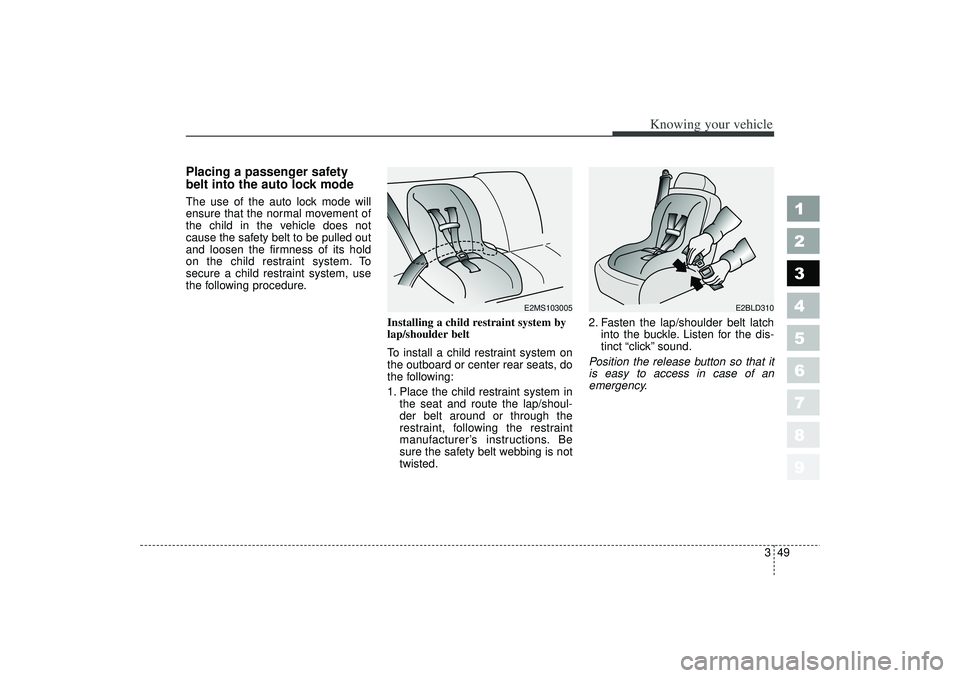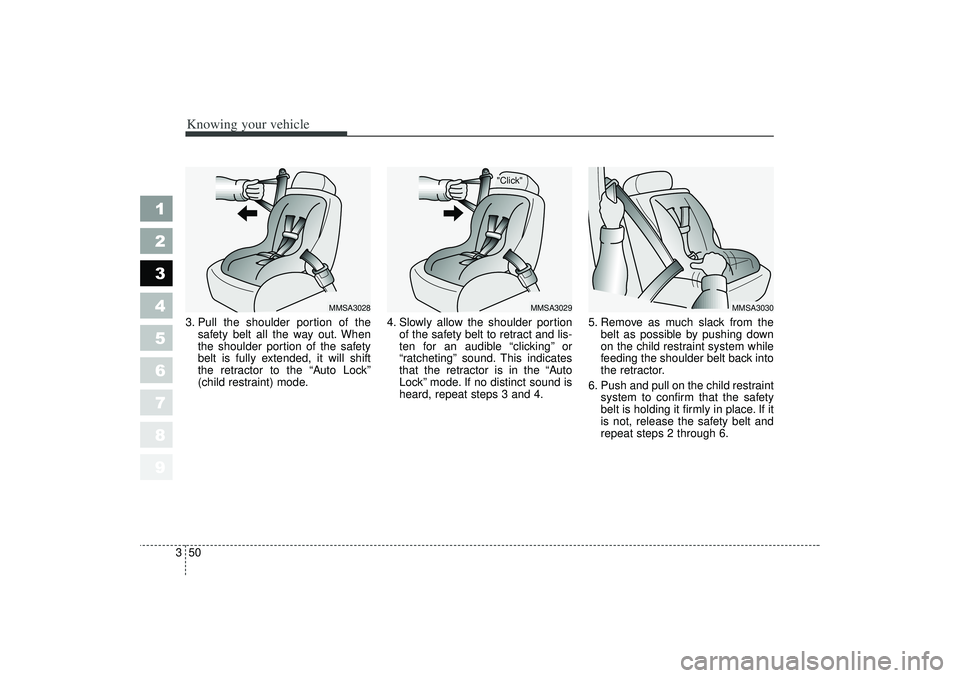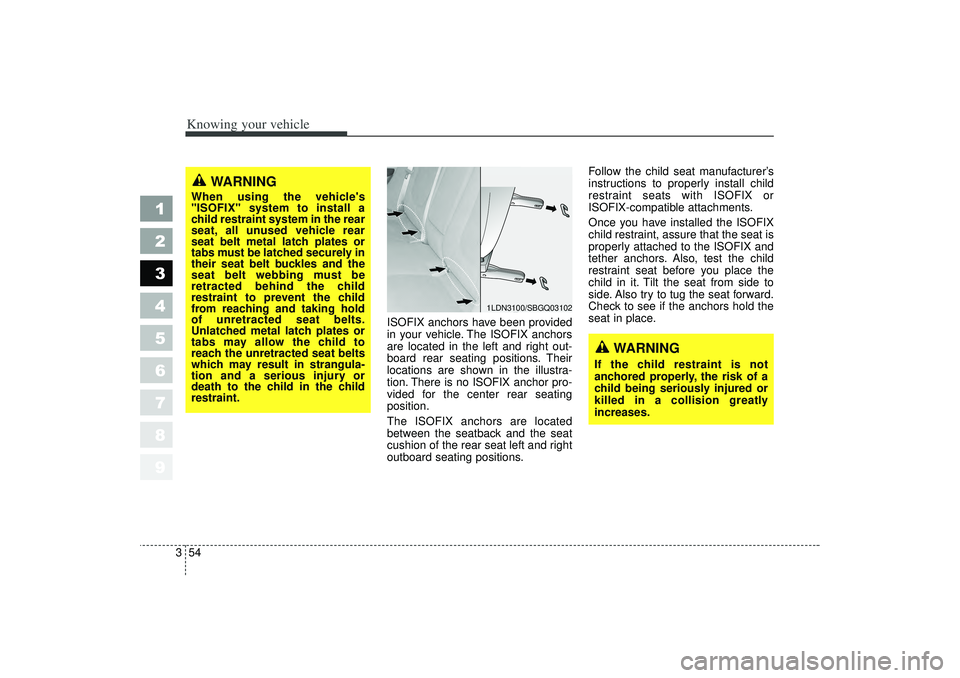2006 KIA SPECTRA5 belt
[x] Cancel search: beltPage 59 of 273

Knowing your vehicle48
3
1
2
3
4
5
6
7
8
9
Installing a child restraint system
For safety reasons, we recommend
that the child restraint system be
used in the rear seats.
Never place a rear-facing child
restraint in the front passenger
seat, because of the danger that
an inflating passenger side air bag
could impact the rear-facing child
restraint and kill the child.
Since all passenger’ s (except dri-
ver ’s) safety belts move freely under
normal conditions and only lock
under extreme or emergency condi-
tions (emergency lock mode), you
must manually change these safety
belts to the auto lock mode to secure
a child restraint.✽ ✽ NOTICEThe driver’s safety belt incorporates
the emergency lock mode only.
WARNING
Do not install any child
restraint system in the front
passenger seat. Should an
accident occur and cause the
passenger airbag to deploy, it
could severely injure or kill an
infant or child seated in an
infant or child seat. Therefore,
only use a child restraint sys-
tem in the rear seat of your
vehicle.
If the child restraint seat is not anchored properly, the risk of
a child being seriously injured
or killed in a collision greatly
increases.
WARNING
Before installing the childrestraint system, read the
instructions supplied by the
child restraint system manu-
facturer.
If the seat belt does not oper- ate as described, have the
system checked immediately
by your authorized Kia dealer.
Failure to observe this manual instructions regarding child
restraint system and the
instructions provided with the
child restraint system could
increase the chance and/or
severity of injury in an acci-
dent.
LD CAN (ENG) new 3-1~.qxd 7/29/05 10:28 AM Page 48
Page 60 of 273

349
1
2
3
4
5
6
7
8
9
Knowing your vehicle
Placing a passenger safety
belt into the auto lock modeThe use of the auto lock mode will
ensure that the normal movement of
the child in the vehicle does not
cause the safety belt to be pulled out
and loosen the firmness of its hold
on the child restraint system. To
secure a child restraint system, use
the following procedure.Installing a child restraint system by
lap/shoulder belt
To install a child restraint system on
the outboard or center rear seats, do
the following:
1. Place the child restraint system inthe seat and route the lap/shoul-
der belt around or through the
restraint, following the restraint
manufacturer’ s instructions. Be
sure the safety belt webbing is not
twisted. 2. Fasten the lap/shoulder belt latch
into the buckle. Listen for the dis-
tinct “click” sound.
Position the release button so that it
is easy to access in case of an
emergency.
E2MS103005
E2BLD310
LD CAN (ENG) new 3-1~.qxd 7/29/05 10:28 AM Page 49
Page 61 of 273

Knowing your vehicle50
3
1
2
3
4
5
6
7
8
9
3. Pull the shoulder portion of the
safety belt all the way out. When
the shoulder portion of the safety
belt is fully extended, it will shift
the retractor to the “Auto Lock”
(child restraint) mode. 4. Slowly allow the shoulder portion
of the safety belt to retract and lis-
ten for an audible “clicking” or
“ratcheting” sound. This indicates
that the retractor is in the “Auto
Lock” mode. If no distinct sound is
heard, repeat steps 3 and 4. 5. Remove as much slack from the
belt as possible by pushing down
on the child restraint system while
feeding the shoulder belt back into
the retractor.
6. Push and pull on the child restraint system to confirm that the safety
belt is holding it firmly in place. If it
is not, release the safety belt and
repeat steps 2 through 6.
"Click"
MMSA3029
MMSA3030
MMSA3028
LD CAN (ENG) new 3-1~.qxd 7/29/05 10:28 AM Page 50
Page 62 of 273

351
1
2
3
4
5
6
7
8
9
Knowing your vehicle
7. Double check that the retractor isin the “Auto Lock” mode by
attempting to pull more of the safe-
ty belt out of the retractor. If you
cannot, the retractor is in the “Auto
Lock” mode.
To remove the child restraint, press
the release button on the buckle and
then pull the lap/shoulder belt out of
the restraint and allow the safety belt
to retract fully.
✽ ✽ NOTICEWhen the safety belt is allowed to
retract to its fully stowed position,
the retractor will automatically
switch from the “Auto Lock” mode
to the emergency lock mode for nor-
mal adult usage.
WARNING
- Auto lock
mode
The lap/shoulder belt automati-
cally returns to the “emergency
lock mode” whenever the belt is
allowed to retract fully.
Therefore, the preceding seven
steps must be followed each
time a child restraint is
installed.
If the safety belt is not placed in
the “auto lock” mode, severe
injury or death could occur to
the child and/or other occupants
in the vehicle in a collision,
since the child restraint will not
be effectively held in place.
LD CAN (ENG) new 3-1~.qxd 7/29/05 10:28 AM Page 51
Page 64 of 273

353
1
2
3
4
5
6
7
8
9
Knowing your vehicle
Child seat lower anchors
Some child seat manufacturers
make child restraint seats that are
labeled as International Standards
Organization Fixed (ISOFIX) or
ISOFIX-compatible child restraint
seats. These seats include two rigid
or webbing mounted attachments
that connect to two ISOFIX anchors
at specific seating positions in your
vehicle. This type of child restraint
seat eliminates the need to use seat
belts to attach the child seat for for-
ward-facing child restraint seats in
the rear seats.There is a symbol located on the
lower portion of each side of the rear
seatbacks. These symbols indicate
the position of the lower anchors for
child restraints so equipped.
1LDN3050
WARNING - Child restraint anchorage
Child restraint anchorages are designed to withstand only
those loads imposed by cor-
rectly fitted child restraints.
Under no circumstances are
they to be used for adult seat
belts or harnesses or for
attaching other items or
equipment to the vehicle.
The tether strap may not work properly if attached some-
where other than the correct
tether anchor.
1LDN3100/1LDN3100AChild lower anchor
Label
LD CAN (ENG) new 3-1~.qxd 7/29/05 10:28 AM Page 53
Page 65 of 273

Knowing your vehicle54
3
1
2
3
4
5
6
7
8
9
ISOFIX anchors have been provided
in your vehicle. The ISOFIX anchors
are located in the left and right out-
board rear seating positions. Their
locations are shown in the illustra-
tion. There is no ISOFIX anchor pro-
vided for the center rear seating
position.
The ISOFIX anchors are located
between the seatback and the seat
cushion of the rear seat left and right
outboard seating positions. Follow the child seat manufacturer
’s
instructions to properly install child
restraint seats with ISOFIX or
ISOFIX-compatible attachments.
Once you have installed the ISOFIX
child restraint, assure that the seat is
properly attached to the ISOFIX and
tether anchors. Also, test the child
restraint seat before you place the
child in it. Tilt the seat from side to
side. Also try to tug the seat forward.
Check to see if the anchors hold the
seat in place.
WARNING
If the child restraint is not
anchored properly, the risk of a
child being seriously injured or
killed in a collision greatly
increases.
1LDN3100/SBGQ03102
WARNING
When using the vehicle's
"ISOFIX" system to install a
child restraint system in the rear
seat, all unused vehicle rear
seat belt metal latch plates or
tabs must be latched securely in
their seat belt buckles and the
seat belt webbing must be
retracted behind the child
restraint to prevent the child
from reaching and taking hold
of unretracted seat belts.
Unlatched metal latch plates or
tabs may allow the child to
reach the unretracted seat belts
which may result in strangula-
tion and a serious injury or
death to the child in the child
restraint.
LD CAN (ENG) new 3-1~.qxd 7/29/05 10:28 AM Page 54
Page 68 of 273

357
1
2
3
4
5
6
7
8
9
Knowing your vehicle
➀
Driver’s airbag
(see page 3- 60)
➁
Front passenger’ s airbag
(see page 3- 61)
➂
Side airbag (if equipped, see page 3- 67)
➃
Curtain Airbag(if equipped, see page 3- 68)
➄ Front impact sensor
(see page 3- 69)
\b
Side impact sensor(if equipped, see page 3- 69)
➆
SRS Control Module (see page 3- 69)
➇
Front seat position sensor
➈
Occupant classification system(see page 3- 62)
Airbag inflation condition(see page 3- 70)
Airbag non-inflation condition(see page 3- 72)
Airbag warning light(see page 3- 77)
Airbag service(see page 3- 77)
Airbag warning label(see page 3- 79)
What your airbag system doesDriver’s airbag and front passenger’ s
airbag are designed to supplement
the protection offered by the safety
belt in certain frontal collisions.
Likewise, side airbag and curtain
airbags (if equipped) are designed to
supplement the protection offered by
the safety belt in side collisions.
Safety belts are designed to reduce
the injury of the driver or passengers
in case of light impact or collision.
However, to help reduce impact on
driver or passengers in a serious col-
lision, seat belts must also be cor-
rectly worn.What your airbag system does
not doThe air bag system is designed to
supplement the protection offered by
the safety belt system. IT IS NOT A
SUBSTITUTE FOR THE SAFETY
BELT.
The importance of using
safety beltsThere are four very important rea-
sons to use safety belts even with an
airbag supplemental restraint sys-
tem. They:
help keep you in the proper posi-
tion (away from the airbag) when it
inflates.
reduce the risk of harm in rollover,
side impact (vehicles not equipped
with side and curtain airbags) or
rear impact collisions, because an
airbag is not designed to inflate in
such situations and even a side
curtain airbag is designed to inflate
only in certain side impact colli-
sions.
reduce the risk of harm in frontal or
side collisions which are not
severe enough to actuate the
airbag supplemental restraint sys-
tem.
reduce the risk of being thrown
from your vehicle.
LD CAN (ENG) new 3-1~.qxd 7/29/05 10:28 AM Page 57
Page 69 of 273

Knowing your vehicle58
3
1
2
3
4
5
6
7
8
9
Airbag system components The main components of your SRS
are:
To indicate that your vehicle is
equipped with airbags, the corre-
sponding airbag covers are
marked with “SRS AIRBAG”.
- Driver’ s airbag (see page 3- 60)
- Passenger’ s airbag(see page 3- 61)
- Side airbag (if equipped, see page 3- 67)
- Curtain airbag (if equipped, see page 3- 68)
A diagnostic system that continual-
ly monitors the system operation.
An indicator light to warn you of a
possible problem with the system.
Emergency power backup in case
your car’ s electrical system is dis-
connected in a crash.
WARNING
- Airbags &
safety belts
Even in vehicles with air bags, you and your passengers
must always wear the safety
belts provided in order to min-
imize the risk and severity of
injury in the event of a colli-
sion or rollover.
Always wear your safety belt. It can help keep you away
from the air bags during heavy
braking just before a collision.
If occupants are not fastened or correctly seated, they can-
not be protected, and thus
face serious injury or death.
Driver’s and front passenger’s airbag are designed to inflate
only in certain frontal colli-
sions, and side and curtain
airbags (if equipped) are
designed to inflate in certain
side impacts.
(Continued)
(Continued)They will generally not provide
protection in side impacts
(vehicles not equipped with
side and curtain airbags) or
rear impacts, rollovers, less
severe frontal collisions. They
will not provide protection
from later impacts in a multi-
impact collision.
If your vehicle has been sub- jected to flood conditions (e.g.
soaked carpeting/standing
water on the floor of the vehi-
cle, etc.) or if your vehicle has
become flood damaged in any
way, do not attempt to start
the vehicle or put the key in
the ignition before discon-
necting the battery. This may
cause airbag deployment,
which could result in serious
personal injury or death. If
flooded conditions are sub-
jected to your vehicle, before
starting the vehicle, have the
vehicle towed to an authorized
Kia dealer for inspection and
necessary repairs.
LD CAN (ENG) new 3-1~.qxd 7/29/05 10:28 AM Page 58